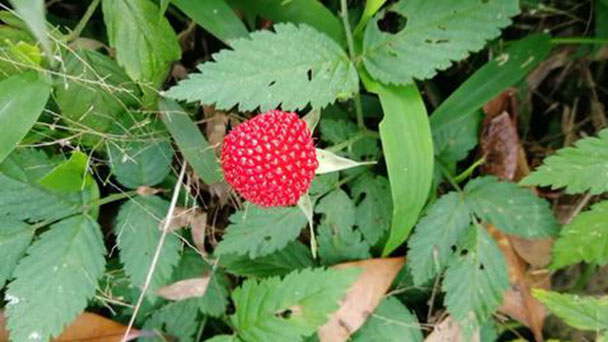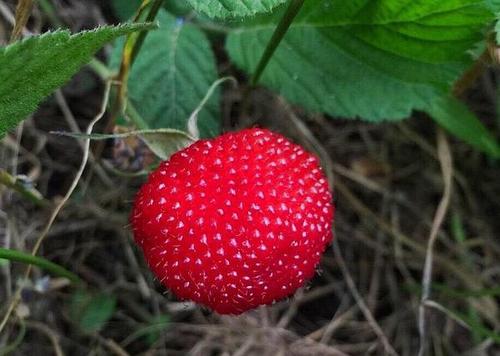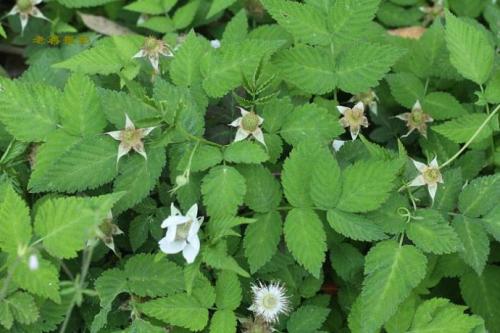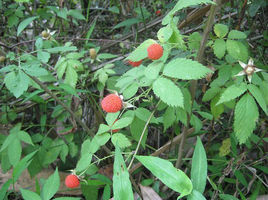Thimbleberry (Rubus rosifolius) profile
Written by Maggie
Mar 10 2021

Thimbleberry (Rubus Rosaefolius Smith): Branchlets are cylindrical, pilose or subglabrous, often with pale yellow glandular spots, sparsely more erect prickles. Leaflets are ovate-lanceolate or lanceolate, acuminate at the top, round at the base, sparsely pubescent on both sides, with light yellow glandular spots, sparsely small prickles along the midrib below, and sharp indentation on the edge of double serrated; Terminal leaflets and axles of Thimbleberry are pubescent and small prickles, dotted with light yellow glandular spots; Stipules are ovate-lanceolate or lanceolate, pilose.
Thimbleberry picture

Morphological characteristics of Thimbleberry
Branch
Thimbleberry is an erect or climbing shrub, 2 -- 3 m tall; Branchlets are cylindrical, pilose or subglabrous, often light yellow glandular spots, sparsely more erect prickles.
Leaf
Thimbleberry has 5-7 leaflets, ovate-lanceolate or lanceolate, 3-5 (7) cm long and 1.5-2 cm wide, acuminate at the top, rounded at the base, sparsely pubescent on both surfaces, almost glabrous when old, with light yellow glandular spots, sparsely small prickles along the midrib below, and sharply incised double serrations at the margin; Petiole of Thimbleberry is 2-3 cm long, terminal petiole 0.8-1.5 cm long, both pilose and prickly, sometimes subglabrous, dotted with pale yellow glandular dots; Stipules are ovate-lanceolate or lanceolate, pilose; Flowers are often 1-2, terminal or axillary.
Flowers
Pedicels of Thimbleberry are 2 -- 3.5 cm long, with less or more densely pubescent, sparsely prickled, sometimes glandular; Flowers are 2-3 cm in diameter; Calyx pilose and glandular spots outside; Sepals are lanceolate or ovate-lanceolate, apex long-tail tip, often reflexed after anthesis; Petals of Thimbleberry are oblong, oblong obovate or suborbicular, 1 -- 1.5 cm long, 0.8 -- 1 cm wide, white, base clawless, longer than sepals, outside pubescent, gradually falling; Filaments are wider; Pistils many, styles and ovaries glabrous; Receptacle short stipitate.
Fruit
The fruit of Thimbleberry is ovoid or oblong-ovoid, 1 -- 1.5 cm long, red, rich in red pigment, shiny, glabrous; The nucleus has deep pit pores.
The ecology of Thimbleberry
Thimbleberry is found in the shade of mountain forests, on grassy slopes or on alpine humus soil, up to 2,000 meters above sea level.
Thimbleberry likes to be warm and shaded. Pleas in humus-rich forest margin or mountain slopes.
The growing methods of Thimbleberry
Engraftment method
Ground planting, Thimbleberry seedlings are mostly planted in the spring. Choose a high, sunny place. The hole can be dug according to the diameter of 50 cm and the depth of 50 cm. It is best to apply barnyard manure in the hole and pay attention to cover it with subsoil so as not to burn the roots. Usually put a three-year-old seedling in each hole, first righting it, spreading the root system, and then filling the soil. Then pouring permeable once, after 3-5 days, also need to water two water again. Transplanting operations are best performed on cloudy days.
Key points of management
Thimbleberry prefers moist and dry soil conditions but should maintain a water supply during the vigorous growth phase. Its demand for fertilizer is more, in addition to the application of base fertilizer when planting, the growth stage can be every 2-3 weeks of top dressing. Thimbleberry likes to be exposed to sunlight for at least 4 hours a day. Thimbleberry likes warm, afraid of cold, in the temperature range of 14-26℃ growth is better, overwintering temperature should not be lower than -5T. In practical cultivation, Thimbleberry will be harmed by powdery mildew and black spot and will be invaded by such harmful animals as pear siphon, dragonfly, roseworm ant and demoiselle moth, etc. If it happens, timely measures should be taken to deal with it.
Plant fixed number of year
Thimbleberry is a perennial with a long life span and can be grown in situ for more than 10 years. If there is a continuous decline in growth and other phenomena occur, you can consider the renewal. Be careful not to continue cropping, it is best to change the land planting.

Thimbleberry's propagation
Thimbleberry is a convenient raw material for the extraction of natural plant pigments due to its easy cultivation, rapid reproduction and large yield.
Thimbleberry is mainly propagated by cuttings, mostly in the spring and autumn.The seedling can also be raised by dividing plants and laying strips. Appropriate to choose good drainage, loose and fertile loam.
Thimbleberry's breed classification
Double Thimbleberry(Variant)
Double white, aromatic, 3 -- 5 cm in diam.
Double Thimbleberry June-Jul.
Thimbleberry's area of distribution
Thimbleberry is made in Jiangxi, Hunan, Anhui, Zhejiang, Fujian, Taiwan, Guangdong, Guangxi, Sichuan, Guizhou.
Thimbleberry is also found in India, Burma, Thailand, Laos, Vietnam, Cambodia, Japan, Indonesia (Java), Oceania, Africa, Madagascar.
Thimbleberry uses
Medical use
The whole plant of Thimbleberry can treat dysentery, irregular menstruation, menorrhagia, vomiting, children cough, scald.Root (touching the umbrella upside down): thin, slightly bitter, cool. Thimbleberry can clear heat and detoxification, activating blood and relieving pain, stopping belt, anti-perspiration, relieving cough and stopping dysentery. For inverted menstruation, cough, phlegm asthma, night sweats, anal prolapse, red dysentery, cough in children.
Landscape use of Thimbleberry
Thimbleberry white flowers and red fruits are gorgeous and pleasing to the eye and fragrant. Thimbleberry can be planted in the semi-wild state in the natural garden or the garden with a strong natural landscape, and can also be planted on the edge of the hedge or forest.

Latest Updated
- Benefits of Bugleweed - 7 Science-backed Health Benefits
- Bugleweed Dangers & Side Effects - Is It Poisonous?
- How to Plant Evergreen Trees - What You Should Know
- When to Plant Evergreens - Grow Guide for Evergreen Trees
- 12 Wonderful Evergreen Shrubs for Your Garden
- 12 Popular Evergreen Plants with Pictures for Beginners
- When And How To Prune A Lilac Bush Like a Pro
- How to Grow & Care for Lilac Vine (Hardenbergia Violacea)
- Japanese Lilac Tree (Syringa Reticulata) Care & Propagation Guide
- Shumard Oak Pros and Cons - What to Know
Popular Articles
- Winter maintenance of Antirrhinum Majus
- How to Grow Terminalia Mantaly Tree
- How to Grow and Care for Crossostephium Chinense
- How to grow Antirrhinum Majus in spring
- Peristeria Elata (Dove Orchid) Profile: Info & Care Guide
- Underwatered Snake Plant (Sansevieria Trifasciata) - Signs And How To Fix
- How to Care for Brazilian Jasmine Plant (Mandevilla Sanderi)
- How to Grow & Care for Graptopetalum Purple Delight in Summer
- Rosa Chinensis (China Rose): Plant Growing & Care Tips
- How to Care for Baby Sun Rose (Aptenia Cordifolia)